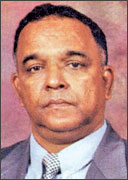|

Thilaka
V. WIJEYARATNAM
In a cosy cove nestling comfortably, slumbers the little town of
Gosford, in Sydney, Australia. Suddenly at 3.15 p.m. it comes to life,
for it's the time for Pelican feeding. Of Pelicans said a poet: "Pelicane's
beak can hold more than its belly can."
Quite true. The long beaked birds with a pouch, like biological
clocks come to a certain spot exactly at 3.30 pm. An organisation
thought of attracting Pelicans by offering them a feast of fish. Steps
are built along the site for spectators to watch this performance.
Around 3.15 p.m., the Pelicans start coming in one by one, then in
groups. Some wait at a safe distance to see how things are going before
they saunter in. Come these delightful creatures with wings spread and
limbs together they glide gracefully through the air and land elegantly
on the surface of the water and then do a little surf-riding so like an
expert - for a distance, do a sharp turn and come to the feeding spot.
While watching this refined performance one cannot help but think of the
vibrant ballerina Dame Margot Fontayne or the Russian Ballerina Vlanova
of Swanlake fame - only there is not one ballerina but a whole bunch of
them
So elite, so elegant, so graceful, so remarkably majestic, so
dignified and so very dazzling they are. Once they climb the dais four
they are fed so orderly standing in rows anxiously waiting for the
organisation member to toss the fish. One by one as the fish is tossed
up, snatch it with the long painted beak and move out for the others
turn. But one adjutant bird, could be a leader or a bully, after having
had his catch went back to the last row for a second helping. How very
human, I thought. About two years before I went with a socio-religious
group to Mutur to distribute some items, the Tsunami refugees wanted
kerosene cookers and hurricane lamps. We distributed each to each tent.
In the process we noticed
one refugee in more than one tent not only for a second helping but
many helpings - wouldn't dare say how pelican like!
The organisation member really has a sense of humour she would hold
the fish up and asking "Do you want fish?" swing it up and down - up and
down the heads of the pelicans would go in turn with the hand movement.
It was very entertaining. The beautiful sight of the birds gliding
in, surfing, straddling on the steps and catching and pulping the fish
will ever be etched on one's memory.
A guide for butterflies in Sinhala
  Sri Lanka is one of the top bio-diversity countries in the world.
Quite sadly, however, only a few works on the subject have been authored
in Sinhala. Environment entered the school curriculum as a subject in
1976 for the first time. This period witnessed two major publications on
butterflies in Sinhala: Lakshman Weeratunga's Sri Lanka Samanala Namayan
and Douglas B Ranasinghe's Samanala Sanrakshana. Sri Lanka is one of the top bio-diversity countries in the world.
Quite sadly, however, only a few works on the subject have been authored
in Sinhala. Environment entered the school curriculum as a subject in
1976 for the first time. This period witnessed two major publications on
butterflies in Sinhala: Lakshman Weeratunga's Sri Lanka Samanala Namayan
and Douglas B Ranasinghe's Samanala Sanrakshana.
One
reason for Ranasinghe's interest in contributing to butterfly literature
is his own experience in the field: students did not have a proper
command of butterflies. Many woks are published in English, priced at
exorbitant rates.
Asirimath Samanala Lokaya is the latest of Ranasinghe's painstaking
efforts to introduce the scientific background knowledge on butterflies
in Sinhala. Ranasinghe is helped by Dr. Michael Vanderpooten and
Lakshman Weeratunga for the task.
The book is comprised of 11 chapters explaining the introduction of
butterflies, interrelationship with trees, interrelationship with other
insects, enemy management, mating, migrating, interesting information,
endemic species and maintaining a butterfly garden.
Although it is written in Sinhala, Ranasinghe provides technical and
scientific terms within brackets along with a bibliography for anybody
to pursue any interesting sub area. The book has a list of colourful
images of butterflies as well.
Ranasinghe is currently the president of Wildlife and Nature
Protection Society with 15 publications to his credit. He was honoured
with a Presidential award for environment recently.
|

